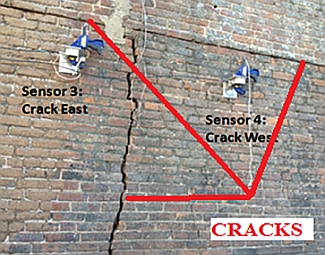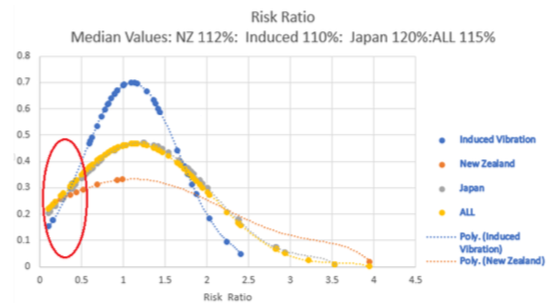What We Offer:
Measure the Performance. Determine the Stability. Understand the Risk
Structural Stability is not Guaranteed
Structural stability is not guaranteed for the lifetime of a building. A building collapse Surfside Florida, and second failure recently in Iowa (see the news video to the right) has precipitated many legal changes around the country. New Laws in Florida , New Jersey and other states as well as guidelines in the Federal Mortgage lenders are requiring an understanding of ‘structural integrity’. ASCE 7, Chapter 1 defines this term and it includes lateral capacity and load distribution. Verifying these required parameters cannot be done with a visual inspection. Effects of aging, corrosion, poor construction, and repeat shock events are all factors that can cause degradation and affect the overall stability of the structure. Building inspections performed by visual methods only point out obvious defects. But a Dynamic Signature Assessment – Lateral Load Test objectively measures and validates the performance of the structure compared to Building Code metrics to determine the stability and to quantify hidden risks to complement a Building Inspection Report. This helps verify Structural Integrity. Load Test methods are identified in ASCE 11-99, the Standard that is referenced in new Structural Integrity Laws.
The button below will take you to a presentation about the recent changes in law in Florida, and comments on other places that are following suit. The course gets you 2 hours of Professional Development and it’s accepted throughout the USA, and elsewhere.
The course describes legal changes and then goes on to discuss the 16 methods commonly used for assessing structural integrity. It then discusses the use of structural dynamics which is the only methodology that gives a holistic measure of the integrity of an entire structure. The importance of the non-linear behavior of parameters is presented together with a mechanism for energy dissipation (stick-slip} that allows an assessment of modal damping that results in realistic values for both wind and seismic induced responses. In-situ load testing using the dynamic response is presented with full scale, in-the-field, examples (subjected to wind, earthquake and forced vibration), together with a review of the reasons for buildings collapsing, and the use of the techniques for calibrating finite element programs used to represent a structure.

Unfortunately, structures can, and do fail. What matters is the magnitude of the failure which can be catastrophic, with a total collapse, or a local failure, making a building unsafe for occupancy. A Lateral Load Test is an essential first step to avoid such failures.
It is the goal of the designer to prevent catastrophic damage under severe events (hurricanes, earthquakes etc.). Understanding how vulnerable a structure is to a large event is important for all parties. As the building ages, it is more susceptible to a failure. A Dynamic Signature Assessment – Lateral Load Test allows for a prediction of the level of damage to expect from the shock event to which the building was designed. It quantifies the risk.
Building Codes Aren’t An Absolute Measure
Building Codes are widely regarded as being an absolute measure of safe design. They are not. This is caused by the fact that they are based on a risk that is acceptable to a local society. Societal acceptance changes with time, and structures will degrade with accumulated damage. Unfortunately, most engineers don’t use testing to provide the needed verification regarding the actual performance of new and existing structures. This leaves decision makers with the unenviable task of making decisions with little useful information. An ethical requirement for all engineers is to verify assumption made in their assessment. Further, the new Florida Law States, “ to the extent reasonably possible, determining the general structural condition of the building as it affects the safety of such building“. A Dynamic Signature Assessment – Lateral Load Test is a one day test and is ‘reasonably possible’ to perform. It provides verification of structural integrity in an objective and accurate form so all parties performed their due diligence to limit their exposure brought on by this new standard of care for the industry.
Dynamic Signature Assessment

In our database of over 800 measured buildings (graph to the right), each dot represents a building measured with the methods used in a Dynamic Signature Assessment – Load Test. The Risk Ratio is an index which tells how closely a building performs compared to code requirements. A value of 1 means the building is at code levels. Those to the left of the 1 value perform below the required level. Our database shows about 10% of structures are well below the risk profile consistent with the codes. These few structures poses a hidden risk to society which continues to be ignored until a shock event occurs. Then excessive damage and sometimes collapse is a result. Most structures perform well, however, now the few weak structures can be understood, so improvements can be performed early, to avoid further damage or even collapse.
A Dynamic Signature Assessment – Load Test is a one-day measurement that will memorialize a structure’s performance, quantify its structural risk profile, and can be used to identify weaknesses or problems. It’s used to help prioritize budgets, validate construction work and assess damage after a wind or seismic event. This method adds a level of confidence in the decision making process that the traditional methods of analysis cannot match.
This advanced approach represents a paradigm shift in understanding structural performance. It helps identify structural risk for all stake holders and is needed for community resilience and public safety.
Download the White Paper
Frequently Asked Questions
Q: Why is it valuable?
A: Codes require a certain level of capacity. Measurements must be taken to validate that the structure has the required capacity. Also to ensure older buildings still retain their capacity.
Q: What is Structural Commissioning?
A: It is an accurate measurement of the dynamic parameters of the whole body movements of a structure.
Q: What does the analysis tell me?
A: It provides a precise measure of the lateral load bearing capacity of the structure. It verifies that the structure meets the design intent relating to dynamic characteristics identified in the codes. Also, it can identify weaknesses, if they exist.
Q: How long does it take?
A: From 2 to 8 hours, depending on building geometry.
Q: How are measurement taken?
A: Sensors are placed at various locations around the structure to get it’s movements. It is non-invasive and can occur without disrupting works or occupants.
Q: Why haven’t people done it in the past?
A: The research community did these measurements to help establish the code requirements, but it was prohibitively expensive and difficult to accomplish in the past.
Q: Why is structural commissioning necessary?
A: ASCE 7-16 now has performance metrics as part of the design requirements. It also references the methods to use to take the measurements. ASCE 11-99 provides various methods for conducting a Load Test. It is an important validation step for any structure to prove it was built as required and has the capacity needed as the structure ages.
Q: How is it accomplished?
A: Professionals trained in taking dynamic measurements are sent to each site with the correct equipment. Measurements are taken at specific locations for a preset duration to meet QA/QC requirements. Data is sent back to the experts for analysis. The experts should be companies with a proven track record of having the skill set of advanced structural dynamics, and have performed the analysis in the past.
Q: Does Structural Commissioning verify that every part of the structure is compliant?
A: No. It give an accurate assessment of the overall holistic building performance. Additional measurements or testing for specific elements or local areas can be used to validate portions of the buildings such as floor vibrations and other performance aspects.
Q: Is it expensive?
A: The technologies that we have today allow for these measurements to be taken quickly and in a cost-effective matter. The costs are well within reason based on efficiencies created with advanced technology.
Q: What companies have used Structural Commissioning and why?
A: It provides value to various types of customers who are responsible for the quality and safety of structures.
- It is used by Engineers, to validate the performance of structures prior to the design of repairs or rehabilitation. Also it is used to diagnose specific problems with a structure.
- It is used by Owners, including REIT’s, Condo Associations and Developers to validate that the structure has the capacity needed.
- It is used by Lawyers in Construction Defect Claims. It has been approved in court for forensic evaluations of structures.
- It is used by bridge and building Contractors, as part of a monitoring program to establish the baseline performance of a structure and to be compared to as part of real-time performance monitoring.
- It is used by City Governments to understand how a group of structures perform as part of their Emergency Management Planning.
- It is used by Insurers to understand the risk of damage to a structure prior to binding a policy. It is also used in the claims process to quantify damage.
Structural Commissioning with a Dynamic Signature Assessment -Load Test is a performance test which acts as a ‘health check’ to accompany a Building Inspection Report. All responsible parties benefit from knowing the real behavior of each structure and it reduces risk and improves safety for all the residents of these structures.
Damping Measurement
Damping is a parameter that describes the energy dissipation of a structure in a mode of vibration. The establishing of the parameter is vital to the assessment of the structure when it is responding to the actions of strong forces.
However, there are several different methods for measuring damping, and since it is a non-linear parameter and most methods use averaging techniques of one form or another, then most estimates have been inaccurate for some time.
A new technique for measuring non-linear damping of civil structures was introduced in the 1980’s. STRAAM Group has refined this technique (The Random Decrement) to avoid a particular mathematical singularity, and to provide a full non-linear assessment. The technique is then coupled with fracture mechanics theory to provide a very powerful indicator of the types of abnormalities (causing energy dissipation) that occur in the structure being investigated.
STRAAM Group is pre-eminent in the use of this technology.